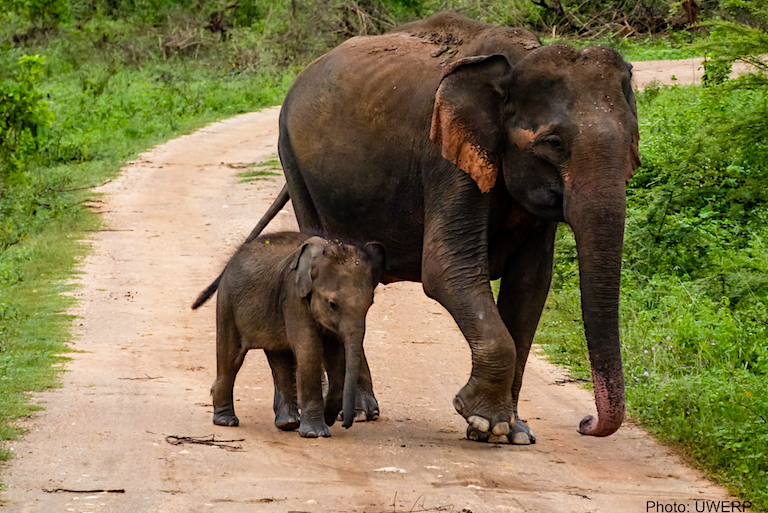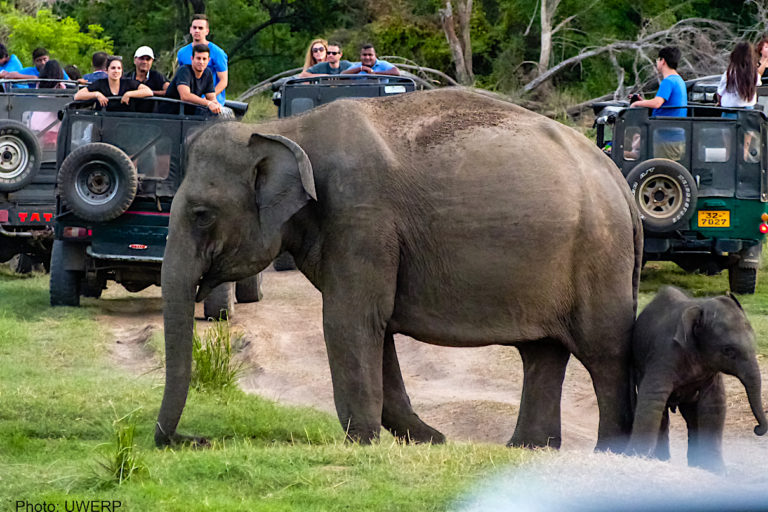- Though we appreciate wild animals like elephants on World Elephant Day (August 12) and every day, travelers and the tourism industry need to stop seeking and promoting hands-on experiences with wild animals, a new op-ed by an elephant researcher argues.
- When humans insist upon touching, feeding, and taking photos with wild animals like elephants, it changes their behavior in ways that can be dangerous, as in the cases of begging for food and habituation.
- The COVID era underscores this: humans have become vectors for the disease, and both wild and captive animals have caught it, so we should exercise caution and limit interactions especially with endangered species.
- This post is a commentary. The views expressed are those of the author, not necessarily Mongabay.
Ordinarily at this time of year, I would have just returned from fieldwork in Sri Lanka, where I have spent more than 14 years studying wild Asian elephants. Summer is a popular travel time not only for scientists but for wildlife tourists. Things are different now. The tourism sector has taken a devastating hit over the past year and a half, thanks to the COVID-19 pandemic.
With vaccine rates up and some international travel resuming, no doubt many are dreaming of the vacations to come as soon as things return to “normal.” But as in so many domains, this unprecedented pause offers an opportunity to reflect carefully on what that “new normal” should look like.
The pandemic has imposed restrictions on many things we took for granted, including basic human contact with one another. We are a species numbering over seven billion. When we become vectors for disease, shouldn’t we exercise at least as much caution in interactions with endangered species that number far less?

Done well, wildlife tourism can provide much-needed support for conservation, along with livelihoods for the people who live with and take care of wildlife. Done wrong, it can pose a grave threat to the very animals we so adore. This is exemplified with Asian elephants, which seem to be viewed by tourists as cute, cuddly gentle giants that are little more than oversized Clydesdales. It doesn’t help that captive elephants are often inaccurately referred to as “domesticated.” Few seem to realize that with a global population of just about 45,000, Asian elephants number 10 times fewer than their African cousins, and are among the most endangered large mammals on the planet.
For many travelers, encountering an elephant up close is a bucket-list experience, either in the wild or captivity. Whenever I tell people my profession, those who have traveled to Southeast Asia are usually eager to tell me about their “life-changing” experience of having interacted with elephants at a so-called sanctuary. Initially set up as a means to support the large population of captive ex-working elephants, captive elephant experiences of various descriptions cater to the desires of tourists, especially Westerners, to commune with these impressive and intelligent beasts.
Not satisfied to merely view the animal from a distance, people want physical contact – to touch, feed, bathe, play with and ride elephants. Wild elephants, too, are often fed by travelers seeking a nice photo-op. No doubt, the human participants greatly enjoy their experience, but what about the elephants?
While much of the international community’s attention has focused on the welfare of animals housed in captive facilities, which can vary greatly, there has been far less attention on the danger that visitors themselves present. Physical contact of any kind with travelers exposes both humans and animals to lethal pathogens from around the world. For example, SARS-CoV-2 is a naturally occurring virus that hopped from wildlife to humans, as did Ebola and HIV earlier. We get alarmed when the transmission occurs from animals to humans. Yet, we have been transmitting diseases to wildlife as well, with relative impunity.
See related: Sri Lanka zoo lion contracts COVID-19 as reports of animal infections rise

Tuberculosis (TB) is a good example. As of 2019, the World Health Organization estimated that up to a quarter of the human population carries TB, one of the top 10 fatal diseases globally and the “leading cause of death from a single infectious agent.” According to the Centers for Disease Control, up to 13 million people in the U.S. alone are likely infected. Those who work at captive animals facilities such as zoos are typically screened for diseases such as TB, but tourists, of course, are not. As a result, humans have passed TB to wildlife through direct contact and our waste.
Animals who habituate to eating our hand-outs can not only be infected by this and other diseases, but they can also become a nuisance that forces authorities to take drastic, if not lethal, action. In Udawalawe National Park, where my research team has been studying elephants for nearly two decades, wild elephants routinely beg for food along the perimeter electric fence. Tourists find it irresistible to feed them fruits handily purchased from nearby street vendors. Some conservationists have argued that this is an economic benefit for local residents that promotes goodwill, and thus not of concern.
But the reality proves otherwise, as exemplified by the story of Rambo. This bull had been a fixture at the fence for well over 20 if not 30 years, the first one to hone the art of begging. Having grown accustomed to being fed, he all but ceased foraging for natural food and was docile enough to be mistaken for a tame animal. Yet over the past year, deprived of his sweet treats due to the pandemic, Rambo has brazenly started raiding adjacent sugar cane plantations on a nearly nightly basis.

Outraged and fearful residents demanded his removal, which wildlife authorities moved to accommodate with plans to transfer him to a holding facility. Following public outcry from others who did not wish to see him end his days in such a facility, this did not materialize. The risk of a fatal encounter between people and Rambo, and others like him, nevertheless remains.
Elephants are not the only species to suffer from what I think of as the perverse result of being loved too much. Carnivores, primates, and many other species are also victims of the human desire to convert emotional attachment to physical contact. But loving a wild animal does not give us the right to interact with it.
COVID-19 is here to stay. We will always be carriers of it and any number of other diseases past and present. Moving forward, I hope travelers and travel companies exert far greater responsibility and restraint to ensure mutual safety for ourselves and the species we so care about. We have grown accustomed to a “no-contact” lifestyle in many ways: can we carry this forward to our interactions with wildlife?
Dr. Shermin de Silva is a conservation researcher and the founder of Trunks & Leaves Inc., a nonprofit dedicated to evidence-based conservation of Asian elephants and their habitats. Additional resources for responsible tourism can be found at their site.
Related from Mongabay’s podcast: ‘Stubborn optimism’ for elephants fuels Indigenous conservation effort, listen here:
